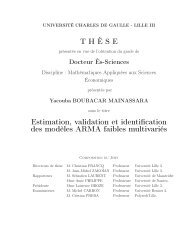A particle-in-Burgers model: theory and numerics - Laboratoire de ...
A particle-in-Burgers model: theory and numerics - Laboratoire de ...
A particle-in-Burgers model: theory and numerics - Laboratoire de ...
Create successful ePaper yourself
Turn your PDF publications into a flip-book with our unique Google optimized e-Paper software.
Mo<strong>de</strong>l <strong>and</strong> motivation Auxiliary steps Results h = 0: coupl<strong>in</strong>g h = 0: <strong>de</strong>f<strong>in</strong>ition, uniqueness h = 0: <strong>numerics</strong>, existence The coupled problem<br />
Case h = h(t): cont<strong>in</strong>uous <strong>de</strong>pen<strong>de</strong>nce en h(·), L ∞ <strong>and</strong> BV stability<br />
Proposition (BV estimate)<br />
The solution constructed for the h = 0 case obeys<br />
u(t,·)BV(R) ց for all t > 0<br />
(at t = 0 the variation may <strong>in</strong>crease by a const. <strong>de</strong>pend<strong>in</strong>g on u0∞,Gλ).<br />
The solution constructed for the fixed-h(·) case obeys the BV estimate<br />
u(t,·)BV(R) u0BV(R) + const(λ,u0∞)+2<br />
t<br />
0<br />
|h ′′ (s)| ds.<br />
Argument: (re)-construct solutions by wave-front track<strong>in</strong>g algorithm<br />
(Dafermos, Hol<strong>de</strong>n-Risebro, Bressan et al. ) (better control of <strong>in</strong>teractions).<br />
Lemma (L ∞ bounds)<br />
We get a uniform L ∞ bound on ad hoc sequences of h ′ (·) <strong>and</strong> u(·,·).<br />
To be precise: if we look at solutions to the coupled problem, we get<br />
max{u∞,h ′ ∞} max{u0∞,|h ′ (0)|}.<br />
For solutions appear<strong>in</strong>g <strong>in</strong> the fixed-po<strong>in</strong>t or splitt<strong>in</strong>g arguments, we get<br />
somewhat weaker bounds.
















